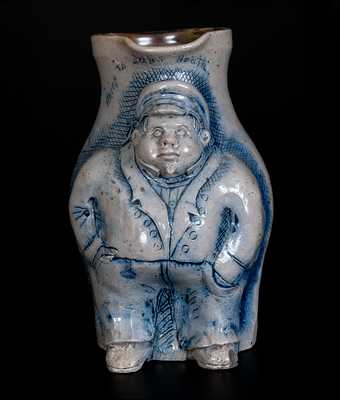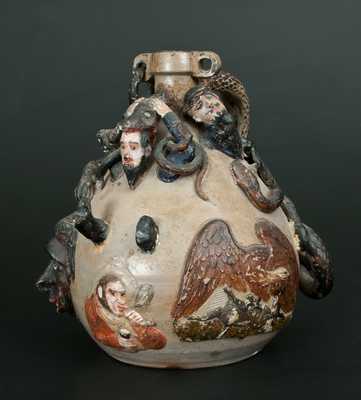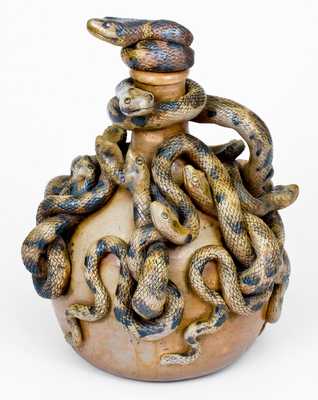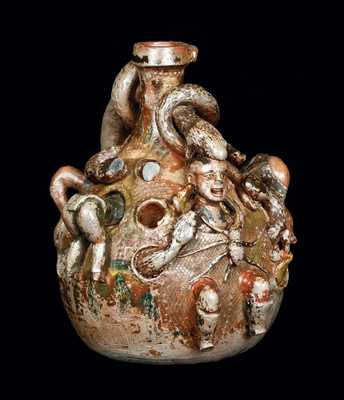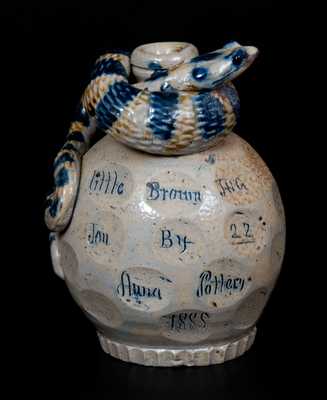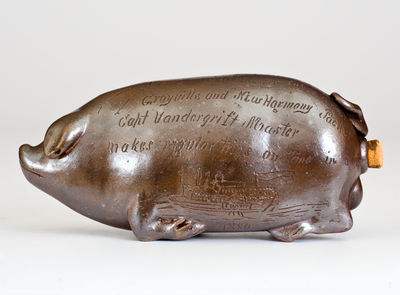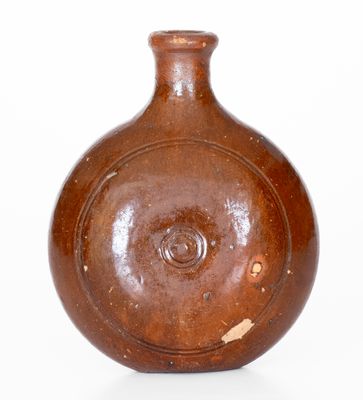Exceedingly Rare and Important Stoneware Temperance Jug with Incised Poem and Original Polychrome-Painted Surface, Inscribed "By J.L. Stone," "First Attempt," and "The Result," John Louis Stone, Limestone County, Texas, circa 1870s, ovoid jug with tall neck and semi-squared spout, decorated with a hand-modeled and sculpted design of the bust, arms, and legs of a mustached man protruding from the vessel's front. Delicately-crafted, the rendering includes incised hair to the figure's head, eyebrows, and mustache, an exposed tongue, a liquor bottle in his hand, and snakes slithering from his boots. Between the figure's legs are the incised words, "The Result," identifying the man as one trapped within the jug, completely consumed by the evils of alcohol. This "Result" is displayed in graphic detail as three snakes, biblically symbolic of deception and moral decay, pursue the man. The jug's girthy handle, modeled in the form of a heavily-scaled rattlesnake curling around the body of the jug seemingly extends through the jug's neck, devouring the figure headfirst. A second large snake sinuously traverses the body of the jug, facing the man's head, ready to strike. A third, smaller snake does the same, descending the shoulder and curling around the man's neck. A hand-modeled frog decorates the shoulder, resting his front legs atop the smaller snake. The bottom half of a man's body (referred to in related works by the Kirkpatrick brothers as a "nice young man going in") adorns the side of the jug, skillfully modeled and sculpted with seams and buttons on his coat, straps and other details on his boots, and even wrinkles formed on his pant leg. The inscription beside this figure reads, "First Attempt," noting that this man is having his first taste for alcohol, but is not yet trapped. While his upper body is plunged or partially stuck within the vessel, he still belongs to the outside world. A large poem below this figure, inspired in part from the inscription on the Gates of Hell in Dante's Inferno, reads "Abandon hope / all who enter in / for they will not, / come out and live, / a sober man again." An incised signature, "By / John L. Stone," appears within a circle at the base on the reverse. This astounding new discovery in American temperance pottery depicts what is believed to be a hand-sculpted self-portrait of its maker, John L. Stone, with mustache and protruding tongue, holding a bottle of liquor. Family photographs of Stone show a remarkable similarity to the drunkard presented on the jug. Stone, who began his potting career at Anna Pottery in Anna, Illinois, with the Kirkpatrick brothers, based this work on their style. A somewhat forgotten but extremely expressive folk artist of his day, Stone's work with the Kirkpatricks began when he was only 10 years old in 1860. He went on to serve an apprenticeship with Moses and Noah Aliff in Mound City, Illinois, from 1866-1867 and was hired by William C. Knox of Oletha (Limestone County), Texas, to move there and superintend his pottery in 1870, subsequently working in nearby Kosse, Texas, as well. (Based on the very few other surviving stone jugs--two made in Oletha and one made in Kosse--this example appears to have been made in the latter location.) Stone spent a long and varied career making pottery, operating also on the West Coast and eventually moving, remarkably, toward the end of his life to Guatemala, where he hoped to help found a self-sustaining American commercial settlement using his skills as a potter. He died in 1927 and is buried in Limestone County. (See Knox's account of his own life in Brick and Clay Record, May 1, 1923, as well as Kurlander, Texas Clay, pp. 20-22.) This work features classic Anna Pottery traits executed in the potter's own distinctive style. Of particular note is the prodigious size of the vessel as well as the larger proportions to the applied figures when compared to Anna examples. In our opinion, this temperance jug is one of the great examples of cold painting in 19th century American utilitarian pottery, a particularly colorful object with various hues and painted details represented and remarkably preserved. The size of the jug and its applied decoration, the quality of the sculpting, and extraordinary original surface of the vessel, arguably define this creation as Stone's finest and most expressive work known. Provenance: Recently surfaced in Texas. Central figure missing one hand and tips of boots. Additional worn spot to proper right boot. Loss to snake's head on proper right boot. Loss to coattail of figure on side, possibly in-the-firing. Paint wear. H 12".





















